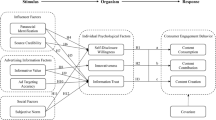Abstract
The present work is framed within the study of advertising evasion online and particularly in social networks. Social networks are a growing phenomenon, where users spend most of their time online and where companies are moving part of their advertising investment, as they are considered an ideal place for commercial campaigns. In order to deepen in the variables that precede advertising evasion in social networks, a relationship model was developed based on the theoretical framework of advertising evasion on the Internet, which was contrasted at an empirical level through a panel of users. For this purpose, a structural equation model was designed, which highlighted the relationships between the main antecedent variables of evasion, such as perceived control, advertising intrusion, and psychological reaction.
Access this chapter
Tax calculation will be finalised at checkout
Purchases are for personal use only
Similar content being viewed by others
References
Fayyad U, Piatetsky-Shapiro G, Smyth P (1996) From data mining to knowledge discovery in databases. AI Magazine 17(3):37–54
Witten I, Frank E (2005) Data mining: practical machine learning tools and techniques, 2nd edn. Morgan Kaufmann Publishers
WEKA 3 (2016) Data mining software in Java homepage. https://www.cs.waikato.ac.nz/ml/weka/
Singh Y, Chanuhan A (2009) Neural networks in data mining. J Theor Appl Inf Technol 5(1):37–42
Orallo J, Ramírez M, Ferri C (2008) Introducción a la Minería de Datos. Pearson Education
Aladag C, Hocaoglu G (2007) A tabu search algorithm to solve a course timetabling problem. Hacettepe J Math Stat 53–64
Moscato P (1989) On evolution, search, optimization, genetic algorithms and martial arts: towards Memetic algorithms. Caltech Concurrent Computation Program (report 826) (1989)
Frausto-Solís J, Alonso-Pecina F, Mora-Vargas J (2008) An efficient simulated annealing algorithm for feasible solutions of course timetabling. Springer, pp 675–685
Joudaki M, Imani M, Mazhari N (2010) Using improved Memetic algorithm and local search to solve University Course Timetabling Problem (UCTTP). Islamic Azad University, Doroud, Iran
Coopers PWH (2014) IAB internet advertising revenue report. http://www.iab.net/insights_research/industry_data_and_landscape/adrevenuereport
Tuzhilin A (2006) The lane’s gifts v. Google report. Official Google Blog: Findings on invalid clicks, pp 1–47
Ponce H, Ponce P, Molina A (2014) Artificial organic networks: artificial intelligence based on carbon networks. In: Studies in computational intelligence, vol 521. Springer
Ponce H, Ponce P, Molina A (2013) A new training algorithm for artificial hydrocarbon networks using an energy model of covalent bonds. In: 7th IFAC conference on manufacturing modelling, management, and control, vol 7, issue 1, pp 602–608
Viloria A, Lis-Gutiérrez JP, Gaitán-Angulo M, Godoy ARM, Moreno GC, Kamatkar SJ (2018) Methodology for the design of a student pattern recognition tool to facilitate the teaching—learning process through knowledge data discovery (big data). In: Tan Y, Shi Y, Tang Q (eds) Data mining and big data. DMBD 2018. Lecture notes in computer science, vol 10943. Springer, Cham
Moe WW (2013) Targeting display advertising. Advanced database marketing: Innovative methodologies & applications for managing customer relationships. Gower Publishing, Londres
Granitto PM, Furlanello C, Biasioli F, Gasperi F (2006) Recursive feature elimination with random forest for PTR-MS analysis of agroindustrial products. Chemometr Intell Lab Syst 83(2):83–90
Kuhn W, Wing J, Weston S, Williams A, Keefer C et al (2012) Caret: classification and regression training. R package, v515
Miller B, Pearce P, Grier C, Kreibich C, Paxson V (2011) What’s clicking what? Techniques and innovations of today’s clickbots. In: Detection of intrusions and malware, and vulnerability assessment. Springer, pp 164–183
Kamatkar SJ, Tayade A, Viloria A, Hernández-Chacín A (2018) Application of classification technique of data mining for employee management system. In: International conference on data mining and big data. Springer, Cham, pp 434–444
Kamatkar SJ, Kamble A, Viloria A, Hernández-Fernandez L, Cali EG (2018) Database performance tuning and query optimization. In: International conference on data mining and big data. Springer, Cham, pp 3–11
Ellison NB, Steinfield C, Lampe C (2007) The benefits of Facebook “Friends:” Social capital and college students’ use of online social network sites. J Comput Med Commun 12(4):1143–1168
Silva J, Hernández-Fernández L, Cuadrado ET, Mercado-Caruso N, Espinosa CR, Ortega FA, Hernández H, Delgado GJ (2019) Factors affecting the big data adoption as a marketing tool in SMEs. In: International conference on data mining and big data. Springer, Singapore, pp 34–43
Author information
Authors and Affiliations
Corresponding author
Editor information
Editors and Affiliations
Rights and permissions
Copyright information
© 2021 Springer Nature Singapore Pte Ltd.
About this paper
Cite this paper
Silva, J. et al. (2021). Factors that Determine Advertising Evasion in Social Networks. In: Gunjan, V.K., Zurada, J.M. (eds) Proceedings of International Conference on Recent Trends in Machine Learning, IoT, Smart Cities and Applications. Advances in Intelligent Systems and Computing, vol 1245. Springer, Singapore. https://doi.org/10.1007/978-981-15-7234-0_81
Download citation
DOI: https://doi.org/10.1007/978-981-15-7234-0_81
Published:
Publisher Name: Springer, Singapore
Print ISBN: 978-981-15-7233-3
Online ISBN: 978-981-15-7234-0
eBook Packages: Intelligent Technologies and RoboticsIntelligent Technologies and Robotics (R0)




